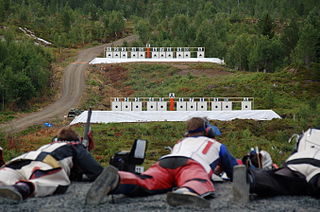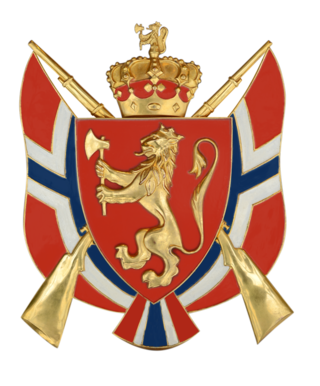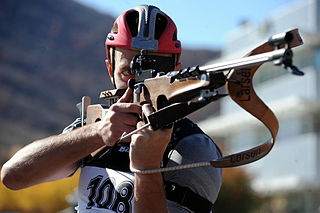
The Krag–Jørgensen is a repeating bolt-action rifle designed by the Norwegians Ole Herman Johannes Krag and Erik Jørgensen in the late 19th century. It was adopted as a standard arm by Norway, Denmark, and the United States. About 300 were delivered to Boer forces of the South African Republic.

Bolt-action is a type of manual firearm action that is operated by directly manipulating the bolt via a bolt handle, most commonly placed on the right-hand side of the firearm. The majority of bolt-action firearms are rifles, but there are also some variants of shotguns and handguns that are bolt-action.

The Karabiner 98 kurz, often abbreviated Karabiner 98k, Kar98k or K98k and also sometimes incorrectly referred to as a K98, is a bolt-action rifle chambered for the 7.92×57mm Mauser cartridge. It was adopted on 21 June 1935 as the standard service rifle by the German Wehrmacht. It was one of the final developments in the long line of Mauser military rifles.

6.5×55mm Swedish, also known simply as 6.5×55mm, 6.5x55 SE, 6.5x55 Swede, or in its native military as 6.5 mm patron m/94, meaning "6.5 mm cartridge model 94", referring to 1894, is a first-generation smokeless powder rimless bottlenecked rifle cartridge. The cartridge has most users in the Scandinavian countries, where it is known as the 6,5×55 or just "the 6,5".
The Sturmgewehr 57 is a selective fire battle rifle designed by Schweizerische Industrie Gesellschaft of Switzerland. The Stgw. 57 assault rifle uses a roller-delayed blowback system similar to the blowback system of the Heckler & Koch G3 and CETME rifles. As an assault rifle, the model AM 55 entered service in the Swiss Army in three designations F. ass. 57 7.5mm and 7.5mm Stgw. 57. Technologically, the Stgw. 57 was the mechanical and design basis for the export-variations of the SG 510 family of small arms. After thirty-three years, from 1957 to 1990, the Swiss Army replaced the Stgw. 57 with the SIG SG 550, a lighter-weight assault rifle.
The Karabiner Modell 1931 is a magazine-fed, straight-pull bolt-action rifle. It was the standard-issue rifle of the Swiss armed forces from 1933 until 1958 though examples remained in service into the 1970s. It has a 6-round removable magazine, and is chambered for the 7.5×55mm Swiss Gewehrpatrone 1911 or GP 11, a cartridge with ballistic qualities similar to the 7.62×51mm NATO/.308 Winchester cartridge. Each rifle included a 6-round detachable box magazine with matching stamped serial number. A stripper clip can be used to load the magazine from the top of the receiver.
The Kongsberg M59 is a sniper rifle produced by Kongsberg Arms of Norway based on left-behind K98k actions from the German World War 2 occupation, in a similar fashion to the later Kongsberg M67. Even though these rifles are sometimes called Mauser M59 and Mauser M67, they were not licensed products of Mauser, but were produced by Kongsberg and marketed as such.

The SIG Sauer SSG 3000 is a bolt-action, magazine fed rifle chambered in 7.62×51mm NATO. It was developed in Germany. It is a common law enforcement sniper rifle in both Europe and the United States. The SSG 3000 was developed by SIG Sauer GmbH and is well renowned for its high quality.

J. P. Sauer und Sohn GmbH is a manufacturer of firearms and machinery and is the oldest firearms manufacturer still active in Germany. The products of this company are frequently referred to as Sauer.

"Swedish Mausers" are a family of bolt-action rifles based on an improved variant of Mauser's earlier Model 1893, but using the 6.5×55mm Swedish cartridge, and incorporating unique design elements as requested by Sweden. These are the m/94 carbine, m/96 long rifle, m/38 short rifle and m/41 sniper rifle. Production began in 1898 at Carl Gustafs stads Gevärsfaktori in Eskilstuna, Sweden.
The Kongsberg M67 is a bolt-action sharpshooter rifle made by Kongsberg Våpenfabrikk of Norway, based on actions from Mauser M98k left by German armed forces in 1945. The M67 replaced the M59 in 1967 and was produced until the 1990s. The rifle is sometimes unofficially referred to as Mauser M67. However, both M59 and M67 were not licensed products of Mauser, but were produced by Kongsberg and marketed as such.
The M52 was the first in a family of target rifles based on refurbished Mauser M 98 military actions by the Danish company Schultz & Larsen in the years following World War II. They were produced to fill a need for target rifles by the Danish shooting association - De Danske Skytteforeninger. The M52 was superseded by later variants the last of which remained in production until the 1970s. It had a similar development path to other Scandinavian target rifles derived from German M98 and other Mauser actions, such as the Kongsberg M59 and Carl Gustaf M63.

Felthurtigskyting, literally field-rapid-shooting, is a practical rifle competition popular in Scandinavia, where the shooter has to engage three different targets placed at different distances with one shot each in the shortest time possible.

Stangskyting, literally Stang-shooting named after Colonel Georg Stang (1858–1907), is a practical rifle competition popular in Norway where dueling shooters have two periods of 25 seconds to get as many hits as possible on a target at an unknown distance, with an unlimited number of rounds. Competitions in Norway are arranged by Det frivillige Skyttervesen.

Det frivillige Skyttervesen (DFS), known in English as the National Rifle Association of Norway, and by DFS themselves as the Norwegian Civilian Marksmanship Association since 2020, is a civilian marksmanship association in Norway and the largest shooting sport organization in Norway. It was created in 1893 by Norway's Storting to promote practical shooting skills within the Norwegian people, thereby empowering the national defence. DFS is sponsored by the Norwegian parliament and receives annually about 30 million Norwegian krones to fulfil their purpose. DFS collaborates with various departments in the Norwegian Armed Forces by educating shooting instructors. They also lend their shooting ranges for free to the Norwegian Home Guard. DFS is under the patronage of Harald V of Norway.

A biathlon rifle is a specialized rifle designed for use in a biathlon event. Specialist biathlon rifles are ultra lightweight, and usually equipped with straight-pull actions, integrated magazine carriers, and ergonomic stock designs suitable for both prone and standing positions.
Sauer 200 is a bolt action rifle introduced by SIG Sauer in 1984 and produced until 1993. The rifle was one of the first consumer rifles with easily replaceable barrels. Sauer 200 has also been sold in Scandinavia under the name Carl Gustaf CG 4000.
Husqvarna 1900, later Carl Gustaf 1900, is a bolt-action rifle developed in Sweden in the 1960s by Husqvarna Vapenfabrik, which also produced the rifle from 1967 to 1970. The rifle was produced in the variants Standard, Monte Carlo, Monte Carlo Lux and a sport model, and got a reputation for having a very high quality. In 1970 the department producing the rifle was sold to Förenade Fabriksverken (FFV), and the production was moved to Carl Gustafs Gevärsfaktori in Eskilstuna without large changes. Production in Eskilstuna was ended in 1979.
Sauer 80, 90 and 92 are bolt-action rifles using a non-rotating bolt with rear-locking lugs expanded against matching lugs inside the rear of the action by rotating the bolt handle down. The rifle is known for having a relatively short-for-the-calibre and very smooth bolt travel and has been described as “The most accurate rifle ever made,” and “These are the smoothest actions you will ever cycle. They are remarkably accurate.” but also for being technically more complicated than the “Gold Standard” Mauser 98 bolt action. The early European and Colt models had a very complicated trigger mechanism and this was later changed in production to a standard shotgun single-set trigger to give adequate safety with simplicity and familiarity of use.
SIG Sauer 205 is a bolt-action rifle formerly produced by SIG Sauer. The rifle was produced in several variants for competition shooting and law enforcement.












